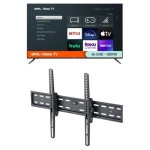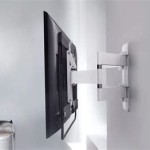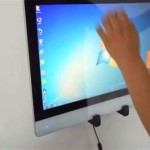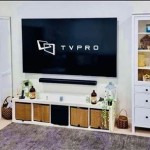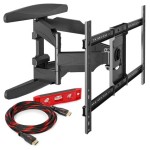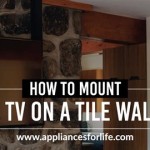Flush Mount TV Wall Brackets: A Comprehensive Guide
Flush mount TV wall brackets, also known as low-profile or ultra-slim mounts, offer a minimalist and space-saving solution for mounting televisions directly against the wall. They prioritize a clean aesthetic and are particularly well-suited for modern interiors where a sleek, unobtrusive appearance is desired. This type of bracket minimizes the gap between the television and the wall, creating a picture-frame effect that blends seamlessly into the viewing environment.
The decision to use a flush mount bracket is often driven by a desire to enhance the visual appeal of a room, especially in situations where space is limited or where the television is intended to become an integral part of the decor. Unlike tilting or full-motion mounts, flush mounts prioritize a fixed viewing angle, making them ideal for environments where the primary viewing location is consistent and directly in front of the television.
Understanding the features, benefits, limitations, and installation considerations of flush mount TV wall brackets is crucial for making an informed decision and ensuring a successful installation. This article provides a detailed overview of the key aspects of flush mount brackets, covering everything from their design and functionality to compatibility and safety.
Understanding the Design and Functionality of Flush Mount Brackets
The design of flush mount TV wall brackets is intentionally simplistic. They typically consist of two main components: a wall plate that attaches securely to the wall studs and two mounting arms that attach to the back of the television. These arms then interlock with the wall plate, creating a rigid and stable connection. The minimal distance between the wall plate and the mounting arms is what allows for the television to sit almost flush against the wall.
The wall plate is usually constructed from heavy-gauge steel to provide the necessary strength and stability. It is designed with multiple mounting holes to accommodate different stud spacing and ensure a secure attachment to the wall. The mounting arms are also typically made from steel and feature a series of holes that conform to VESA (Video Electronics Standards Association) standards. VESA standards specify the standardized hole patterns on the back of televisions, ensuring compatibility with a wide range of bracket types.
The primary function of a flush mount bracket is to hold the television securely in place while minimizing the distance between the screen and the wall. This creates a clean and modern look, making the television appear more like a piece of artwork than a bulky electronic device. However, this functionality comes with certain limitations, such as the inability to tilt or swivel the television after it has been mounted.
Despite the fixed nature of flush mount brackets, some models incorporate small features that add a degree of flexibility. For example, some brackets may offer a slight lateral adjustment, allowing the television to be shifted horizontally by a few inches to accommodate minor alignment issues. Others might include built-in bubble levels to ensure that the television is perfectly level during installation.
It is important to note that the weight capacity of a flush mount bracket is a critical consideration. The bracket must be capable of supporting the weight of the television without any risk of failure. Exceeding the weight capacity can lead to damage to the television, the wall, or both, and can create a serious safety hazard. Therefore, it is essential to carefully check the specifications of the bracket and ensure that it is appropriate for the size and weight of the television.
Key Benefits and Limitations of Choosing a Flush Mount
The primary benefit of a flush mount TV wall bracket is its ability to create a clean, minimalist aesthetic. By positioning the television close to the wall, it minimizes its visual footprint and allows it to blend seamlessly into the surrounding decor. This is particularly advantageous in smaller rooms or in situations where space is at a premium.
Another benefit is the ease of installation. Flush mount brackets are typically simpler to install than tilting or full-motion mounts, as they require fewer adjustments and moving parts. The straightforward design makes the installation process more manageable for DIY enthusiasts, although professional installation is always recommended for optimal safety and security.
Flush mount brackets can often contribute to improved viewing angles, especially when the television is positioned at eye level. Because the television is mounted directly against the wall, there is less chance of glare or distortion from ambient light. This can result in a clearer and more immersive viewing experience.
However, there are also some limitations associated with flush mount brackets. The most significant drawback is the lack of adjustability. Once the television has been mounted, it cannot be tilted, swiveled, or extended, which can be problematic if the viewing angle needs to be adjusted or if access to the back of the television is required for connecting or disconnecting cables.
Another limitation is the difficulty in concealing cables. Because the television is mounted so close to the wall, there is limited space for running cables behind it. This can result in a cluttered appearance if the cables are not properly managed. Cable management solutions, such as in-wall cable concealment kits or cable raceways, may be necessary to achieve a clean and organized look.
Finally, the lack of ventilation can be a concern with flush mount brackets. The close proximity of the television to the wall can restrict airflow, which can lead to overheating, especially for televisions that generate a significant amount of heat. It is important to ensure that there is adequate ventilation around the television to prevent potential damage.
Compatibility and Installation Considerations for Flush Mount Brackets
Ensuring compatibility is the first crucial step before purchasing a flush mount TV wall bracket. The VESA compatibility of the bracket must match the VESA pattern on the back of the television. VESA patterns are specified in millimeters (e.g., 200x200, 400x400) and indicate the distance between the mounting holes. It is essential to consult the television's user manual or the manufacturer's website to determine the correct VESA pattern.
The weight capacity of the bracket must also be considered. The bracket should be able to support the weight of the television with a safety margin. Exceeding the weight capacity can compromise the stability of the mount and create a safety hazard. It is always better to choose a bracket with a higher weight capacity than is strictly necessary to ensure a secure and reliable installation.
Prior to installation, it is important to identify the location of wall studs. Wall studs are the vertical framing members that provide structural support for the wall. The wall plate of the bracket must be securely attached to the studs to ensure that the television is properly supported. A stud finder can be used to locate the studs, and it is important to verify their location with a nail or drill before proceeding with the installation.
The height at which the television is mounted is also an important consideration. The ideal viewing height is typically at eye level when seated. This will vary depending on the height of the viewers and the distance from the television. It is important to measure the viewing height and position the bracket accordingly before attaching it to the wall.
The installation process typically involves attaching the wall plate to the wall studs, attaching the mounting arms to the back of the television, and then interlocking the mounting arms with the wall plate. It is important to follow the manufacturer's instructions carefully and use the appropriate hardware to ensure a secure and reliable installation. A level should be used to ensure that the television is perfectly level, and all screws and bolts should be tightened securely.
Cable management is another important aspect of the installation process. Cables can be routed through the wall using in-wall cable concealment kits, or they can be neatly organized using cable raceways or cable ties. The goal is to minimize the visibility of cables and create a clean and organized appearance.
Finally, it is important to test the stability of the mount after the installation is complete. Gently push on the television to ensure that it is securely attached to the wall and that there is no movement or wobbling. If there is any instability, re-check the installation and tighten any loose screws or bolts. If the installation is not secure, it is best to consult with a professional installer to ensure that the television is properly mounted and safe to use.

Samsung Slim Fit Tv Wall Mount

Samsung Qn55q70caf Q70 Series Tv Recessed In Wall Mounting Kit

Mount It Recessed Tv Wall In Bracket For Flush Installation Fits Screen Sizes 32 70 Inch Tvs

Slim Fit Wall Mount 2024 Flush Tv With Samsung Us

Mount It Recessed Long Extension Full Motion Wall For 32 In 70 Tvs Mi 381 The Home

K2 Mounts Flush Wall Mount For 26 37 Inch Screens Black F B

Recessed In Wall Bracket Flush Mounting Kit For Samsung Un65ls003afxza The Frame 65 Tvs

Mount It Mi 306 Low Profile Fixed Tv Wall

04mm Tb05 32 55 75kg Full Wall Plate Flush Mount Tv Bracket Matchmaster Digital Antenna

Samsung Slim Fit Tv Wall Mount

